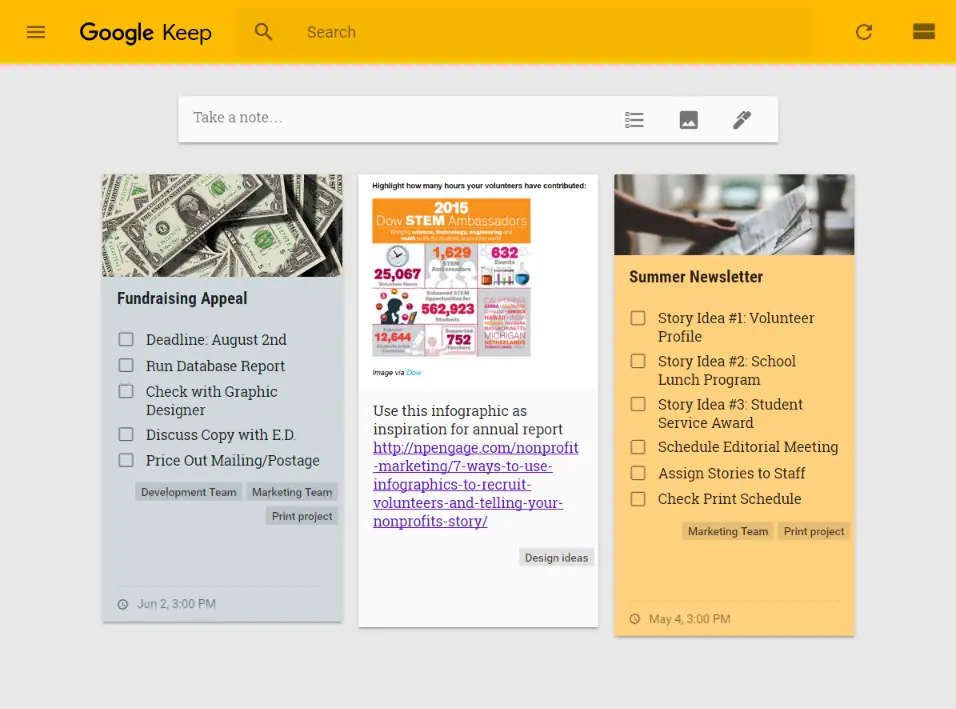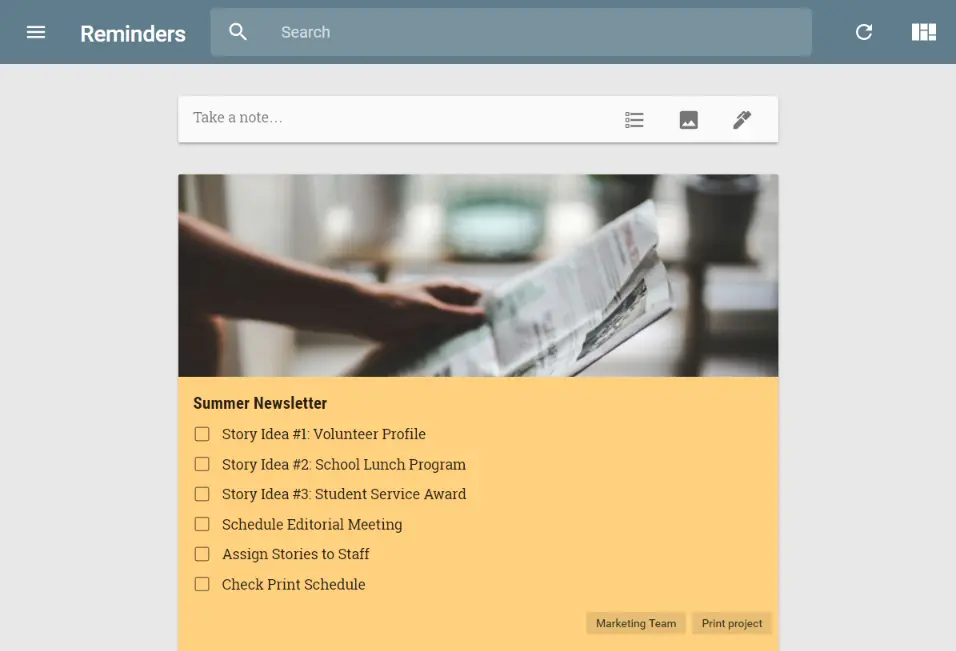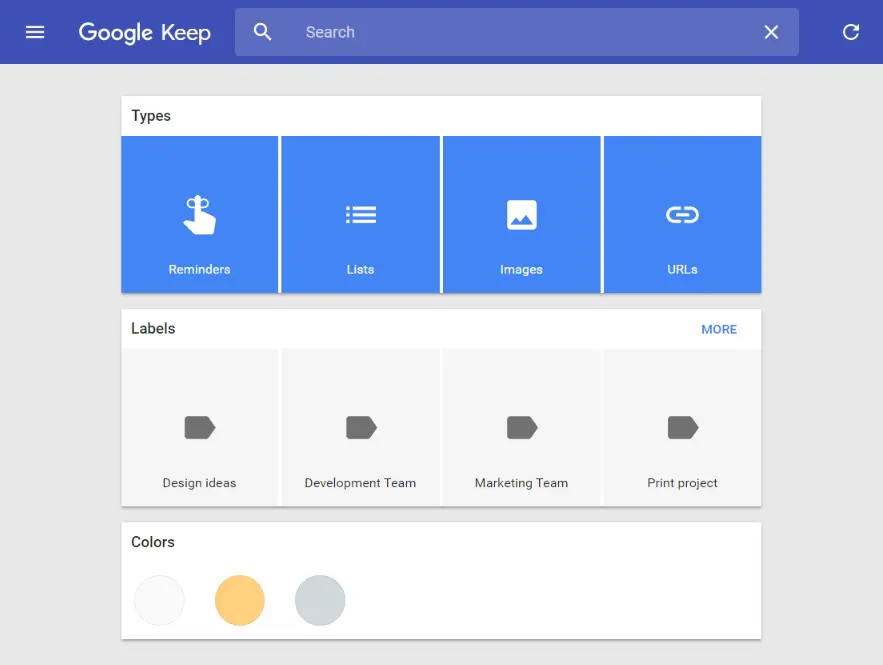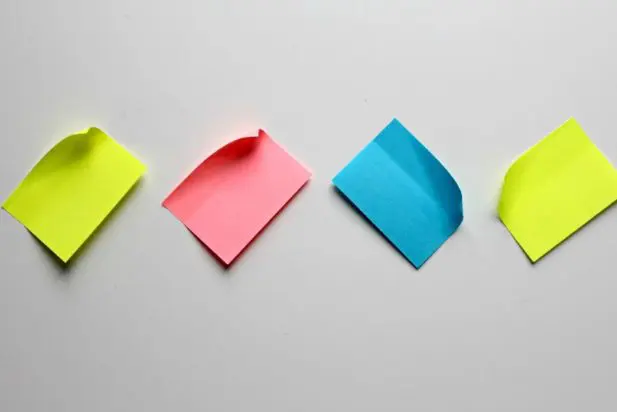Calling all list makers and sticky note fanatics! If you’ve been looking for a simple way to keep track of tasks, ideas and other moments of brilliance, Google Keep is a free and easy-to-use solution that stores everything online.
Let’s explore how you can put it to work at your nonprofit to help manage projects, collaborate with other staff and keep track of important details.
What is Google Keep?
Launched in 2013, Keep is a notetaking service that Google created as a simple but powerful competitor to apps like Evernote. It was recently added to G Suite along with core services like Calendar, Gmail and Google Docs. This means that organizations using G Suite for Nonprofits can centrally manage and offer Keep to everyone on staff.
Over time, Keep has evolved to integrate in new and helpful ways with services like Calendar and Google Docs, which makes it a good choice for notes, lists and basic project management if you’re already using these services.
How Nonprofits Can Use It
It’s not uncommon for nonprofit staff to wear many hats — raise your hand if you’re a fundraiser-marketer or volunteer coordinator-event planner!
Managing multiple projects, deadlines and even people is standard practice that can cause chaos without the right tools to stay on track and coordinate effectively with others. And beyond dealing with the day to day, what should you do with all those great ideas that you hope to implement in the future?
With Keep, nonprofit users have the ability to:
- Manage the status and progress of projects that have multiple tasks, such as the steps to publishing your newsletter and upcoming blog post topics
- Track and store ideas and brainstorms in a way that’s searchable when you have time to come back to them, like a fresh take on the next fundraising appeal
- Consolidate meeting agendas, notes and action items with reminders and collaboration with other team members
- Organize to-do lists and information by event, program, staff person or other custom labels
- Capture online content and links that you can come back to later, including screenshots, which is helpful for content curation on social media
- Sync information across multiple devices so that your lists, notes and ideas are never out of reach, from the field to the fancy gala.
Example
Here’s an example of different notes with images, links, labels, lists and reminder dates:

Get Started with Google Keep
In addition to being a free tool, Keep gets bonus points in my book for being exceptionally easy to get started. Other than having a Google account, there’s no complicated set-up or jargon-filled instructions that you’ll need an IT person to interpret.

- Log in to Keep using your Google account.
- Click the center box to add a title and text to your note.
- If you want to make a list, click the drop down at the bottom on the note (looks like 3 dots) and select Show Checkboxes. Follow the same process to add a drawing.
- To add an image, click the icon that looks like a landscape.
- Explore note customization by changing colors (the paint palette icon) and categorizing with labels (use the drop down).
- Want a reminder about a due date? Use the finger icon to pick a time and/or date. If you use Google Calendar, the reminder will show up there, too.
- Share your note with others in your organization by clicking the person icon and adding their organizational email address.
Are you addicted yet?
To create a new note, click “Done” and start typing in the top box again. Once you have multiple notes, you can start to play with the display by selecting grid or list view in the right side of the yellow banner at the top of the screen. Personally, I love the bulletin board-like feel of the grid view, which is more like Pinterest. Here’s the single column list view:

To search all of your Keep content—including notes, reminders, links, lists, labels and even colors—click in the search bar at the top of the screen to reach this view:

Lastly, when you’re done with a note, you can decide to delete or Archive it. Choose to Archive it if you think you might want to come back to its information, details or steps later on, like for an annual report, staff review or board update.
More Than a Note-Taking App
If you’re ready to take it to the next level, try out these intermediate Google Keep features that keep you synced and organized across devices and when you’re away from your desk.
- Install the Chrome extension and mobile apps for Apple and Android that have the ability to save URLs, text, audio and images along with notes and labels, keeping you organized across devices.
- Transcribe voice memos into text when you don’t have the the time or free hands to write out ideas or make a list. This feature is currently limited to the Android app.
- Copy to Google Docs to expand on your Keep content and take your ideas from conception to completion.
Similar to other Google apps like Calendar and Drive, Keep offers a cost effective solution that doesn’t skimp on functionality and integrations with other Google products. If you’ve been looking for a way to get organized and manage projects without a full blown management software, give Google Keep a try and see if it helps you save time (and sticky notes).
Do you have questions about how to use Google Keep at your nonprofit? Or are there other tools you’ve found that help you stay on track and well-organized? We’d love to hear from you in the comments.

Thanks Katy for those recommendations. I use Trello a lot and it has a free version for tracking to-do lists. I love Evernote but it is not free for sharing in teams so it is great to hear there is a free alternative.
Hi Tarnya! I’ve heard good things about Trello but haven’t used it myself. Thanks for the recommendation of another free tool!